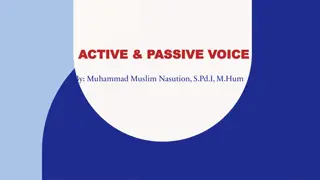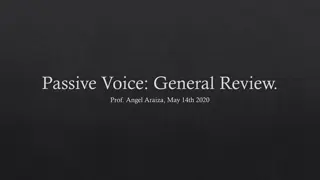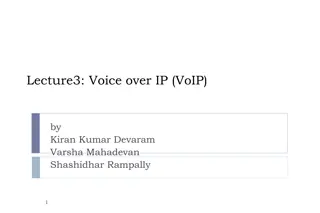Understanding Voice Stress Analysis for Deception Detection
Voice Stress Analysis (VSA) employs technology to detect micro-tremors in the vocal muscles that indicate stress, potentially linked to deception. Developed based on Dr. Lippold's work, VSA systems measure changes in speech characteristics caused by mental stress, aiming to assess the truthfulness of a speaker's account. History reveals the evolution of VSA tools, from the first Psychological Stress Evaluator in 1972 to advancements like the Computer Voice Stress Analyzer. The principle behind VSA lies in detecting muscle response to stress, affecting vocal frequencies imperceptible to the human ear. Learn about the functioning and significance of VSA in lie detection methodologies.
Download Presentation

Please find below an Image/Link to download the presentation.
The content on the website is provided AS IS for your information and personal use only. It may not be sold, licensed, or shared on other websites without obtaining consent from the author. Download presentation by click this link. If you encounter any issues during the download, it is possible that the publisher has removed the file from their server.
E N D
Presentation Transcript
TOOLS FOR DETECTION OF DECEPTION VOICE STRESS ANALYZER
INTRODUCTION The objective of the Voice Stress Analysis is similar to a Polygraph test i.e. to assess whether the subject s version of an event is a true reflection of the facts. In the field of deception detection, Lippold s work has been interpreted to mean that conscious efforts to deceive will result in measurable micro tremors. VSA are computer based systems capable of measuring stress in a person s voice as an indicator of deception. Stressed speech is the speech that exhibits change in characteristics caused by mental stress such as anxiety or fear. All lie detection examination relies upon the fact that telling a significant lie will produce some degree of psychological stress, which causes number of physiological changes. Most VSA do not claim to detect lie but they do claim to detect these micro tremors which might be related to the stress of trying to conceal or to deceive.
HISTORY VSA are based on Dr. Olof Lippold s work. When an individual is under stress, the muscles in our body are tensed to prepare for fight-or-flight. Lippold discovered that all muscles in the human body, including the vocal chords, vibrate at a certain frequency an 8-12 Hz range as muscles tighten and then relax in an effort to maintain tension. Lippold was able to chart these oscillations using electrodes applied to the extensor muscle of the middle finger. He recorded the data on an Electromyograph (EMG), a medical technology designed for evaluating and recording electrical activity generated by muscles in the human body.
First instrument aka Psychological Stress Evaluator was introduced in 1972 by Dektor Counter Intelligence and Security. Inc. which was founded by three retired U.S. military officers Allan D. Bell Jr., Wilson H. Ford, and Charles R. McQuiston Their PSE was met with success but received criticism from the polygraph community. CVSA was introduced as an improvement upon the PSE in 1988. VSA systems are marketed as computer base systems which measures stress in a person s voice as an indicator of deception. Dektor s founders developed the McQuiston-Ford algorithm to measure the frequencies caused by the muscle tremors studied by Halliday, Redfearn, and Lippold.
PRINCIPLE In the same way that any muscle reacts to stress by alternatively relaxing and tensing in fight-or-flight mode, the muscles that control the voice do the same. Once an individual enter into the FOF mode, the basic frequency is diminished and is significantly less. The human voice isn t affected by the changes in the muscle, and there is no sound involved; it is purely a muscle change in response to stress that can t be discerned by our ears but can be analyzed by technology when the voice is captured via microphone. Therefore this technology detects micro-tremors in the muscles of a person s throat and larynx when they speak while relaxed but disappear when speaker experiences stress.
HOW DOES A VOICE STRESS ANALYSIS WORK? The subject being tested is required to complete a consent form giving permission for the test and stipulates who may view the results. The Voice Stress Analyst must explain the reason for the test together with the process to be followed. It is imperative that the subject understands which questions will be asked and what the relation is to the incident. The subject is asked a range of questions that include control questions. The subject s natural body behaviour is measured without any physical attachments unlike a polygraph test. Only a qualified analyst may conduct a Voice Stress Analysis. The natural behaviour of a person, who is experiencing stress, is fight, flight or freeze. This causes their throat muscles to tighten which has an effect on their vocal cords and is picked up in a person s voice. The result to each question asked by the examiner is available immediately. This may lead the examiner to ask more direct question pertaining to a specific object, person and or situation.
FORMULATING OF QUESTIONS TO BE ASKED The outcome of the voice Stress Analysis needs to be carefully considered prior conducting the test. Therefore the questions have to be carefully formulated and have to be event, incident and or subject specific. It is important to remember that the questions need to be Yes/No questions. Relevant questions, which were significant for obtaining the information from the object. The purpose of those questions was to evoke stress, for example during the speaker s deceit. Irrelevant questions were used as a buffer between the relevant questions. The purpose of those questions was to introduce some break and the speaker s relaxation and they were not related to the topic of the discussion. Control questions reveal the truth and their purpose is to demonstrate the comparison to the relevant question. The recordings are carried out in good acoustic conditions in a quiet room with the dynamic microphone Shure SM 58 SE, the acoustic mixer Behringer Eurorack MX 802A and the external analogue-digital converter Creative Sound Blaster Audigy 2 NX. The signals are recorded with the sampling rate of 44,100 samples per second with 16 bit resolution.
THE ANALYSIS There are 4 phases of analysis: 1stPhase subject s natural level of stress before the monitoring of voice patterns; Calibration of stress levels during the subject s statement and forming a stress base line . This indicates the 2ndPhase Pre Examination of voice patterns; 3rdPhase Examination and analysis of statements and cross questioning; and 4thPhase Direct Questions with Yes and No answers.
RESULT SPECIFICATIONS The results indicate which questions were asked, and if the answers are true reflection of events based on the reaction of a subjects voice. Results can be as follows: Deception Subject is NOT telling the truth; No deception Subject IS telling the truth; Subject not sure - Subject is confused;
ADVANTAGES Allows for a more relaxed atmosphere as the subject is not hooked up to special sensors and pressure cuffs Only a microphone is required. Relies upon involuntary changes in the movements of vocal muscles which cannot be controlled by the subject. Can be used in covert operations and then analyzed with CVSA later. Cost effective, easier to use, less invasive.
DISADVANTAGES The stress is a human reaction to the deception, but it can also be caused by other stimuli. Therefore it would be beneficial to avoid intrusive techniques which demand physical connection of the subject to the detectors. It evokes additional stress which can potentially change the results.























